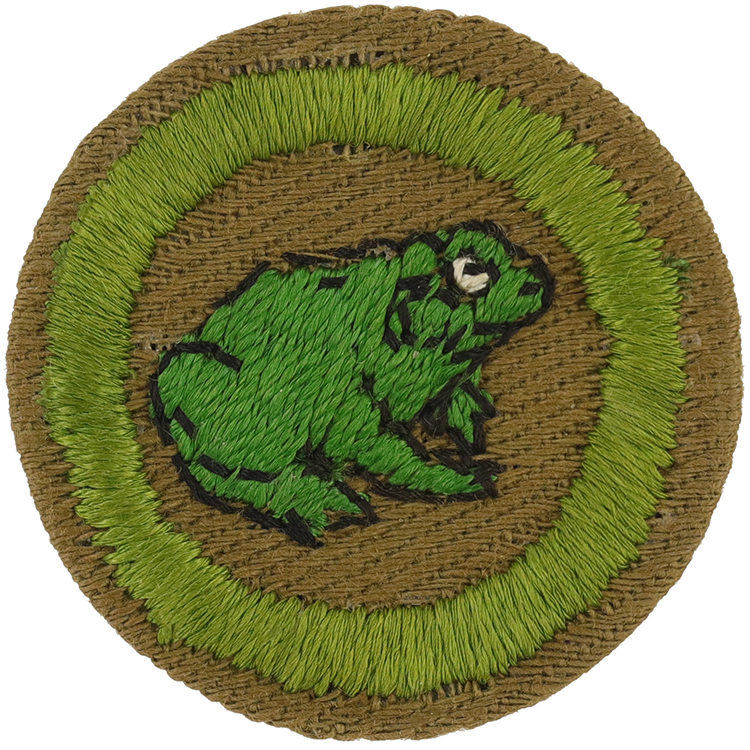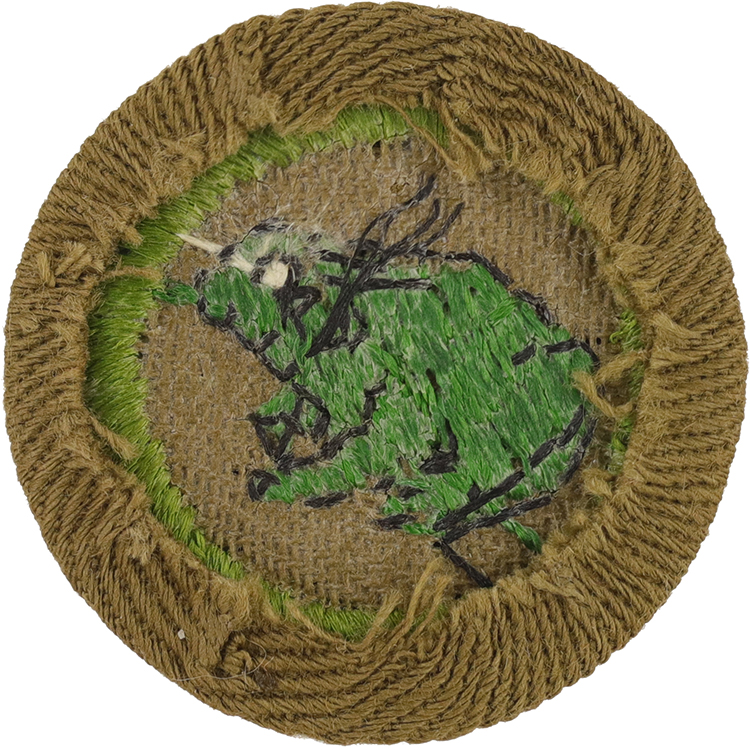
Fig. 1: Zoolog-C4-Front
- Cloth: Lightweight tan right twill
- Embroidery: Cotton loop continuous

Fig. 2: Zoolog-C4-Reverse
- Back: Plain NO imprint with starch
Item Name: Zoology 1939 - 1943
Item ID: Zoolog-C4
Collector Rating: 1
Pamphlets Used to Earn this Badge



Requirements March 1931 until December 1940. Between December 1940 and January 1, 1942 these requirements were optional
1. (a) Name the phyla of animals.
(b) Give the meanings of the names of such phyla.
2. (a) Define the terms vertebrate and invertebrate.
(b) Give example of each.
3. Classify into vertebrate or invertebrate, and name the phylum or class of each the following: bees, crayfish, worms, snails, spiders, sponges, cats, birds, snakes, bats, jellyfish, corals, oysters, butterflies, amoeba, paramecia, man.
4. Know the correct methods of dissecting an invertebrate and a vertebrate.
5. Be able to dissect a frog and a worm.
6. In the frog find and tell uses of: ear, tongue, lung, stomach, small intestine, large intestine, anus, liver, heart, nerves, blood vessels.
7. In the earthworm, find and tell uses of: mouth, pharynx, esophagus, crop, gizzard, intestine, dorsal blood vessel.
8. Draw the arterial system of the frog and the circulatory system of the earthworm.
9. (a) Know what a fertilized egg is.
(b) Describe its development to the end of the gastrula stage of the embryo.
10. Define zoology.
Requirements January 1, 1942 until September 1944. Between December 1940 and January 1, 1942 these requirements were optionall
1. Make five field trips of at least two hours each (preferably at different seasons) to observe wild animal life. Keep records of such trips, listing all animals seen, with date, place, nature of locality and observations of animals and their habits. (Photographs, sketches, track casts, etc., will add to the interest of this record.)
2. Using the "keys" of the modern system of classifying animal life, show ability to classify at least five animals of different phyla.
3. Find out the life processes that are common to all animal life (birth, self protection, feeding, breathing, etc.). Keep record from personal observation of the life cycle and habits of at least two animals of different phyla.
4. On a map of his locality (showing such things as forests, plains, streams, marshes, arid areas, etc.) indicate animals found in each habitat. Know what is being done in his State to protect wild animal life.
5. Carry out one of the following projects:
(a) Keep a young animal, (completely weaned from mother) such as a squirrel, white rat, rabbit, or guinea pig for at least three months. Keep a weekly diary of its habits, food requirements, gain in weight, general health, etc.
OR
(b) Maintain an aquarium or "toad pen" for at least three months. Stock from local ponds, streams, or marshes. Watch development from egg on, of frogs, toads, turtles, fish, or whatever animal he has chosen for special observation. Keep record of life cycle and habits.
OR
(c) Submit at least ten photographs or sketches based on his own observation of microscopic animal life in the field for a period of at least three months. Present at least three properly prepared slides of microscopic life.
Note: Animals, in the zoological sense, include all living organisms other than plant life, from amoeba up through man. However, since birds, snakes and insects are covered in other Merit Badge subjects, choose other examples of animal life for these requirements.
